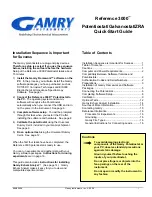
Section 6. Data Table Declarations and Output Processing Instructions
6-22
Point
Crossing
Source
2nd Dim
Source
Action
1
0.5
.7
First value, no counts
2
1.2
1.8
Add one count to first crossing,
second 2D bin, the signal crossed
1
Histogram:
2D < 1.25
1.25<2D<2.25
2.25<2D<3.25
Cross 1
0
1
0
Cross 1.5
0
0
0
Cross 3
0
0
0
3
1.4
.7
No levels crossed, no counts
4
0.3
.7
Crossed a level but was falling
edge, no counts
5
3.3
2.7
Add one count to first, second, and
third crossing bins in the third 2D
bin, the signal crossed 1, 1.5 and 3.
Histogram:
2D < 1.25
1.25<2D<2.25
2.25<2D<3.25
Cross 1
0
1
1
Cross 1.5
0
0
1
Cross 3
0
0
1
Note that the first bin of the second dimension is always “ open” . Any value
less than the specified boundary is included in this bin. The last bin of the
second dimension is always “ closed” . It only includes values that are less than
its upper boundary and greater than or equal to the upper boundary of the
previous bin. If you want the histogram to be “ open” on both ends of the
second dimension, enter an upper boundary for the last bin that is greater than
any possible second dimension source value.
The crossing levels and the boundaries for the second dimension are not
specified in the LevelCrossing instruction but are contained in variable arrays.
This allows the levels to be spaced in any manner the programmer desires.
The arrays need to be dimensioned to at least the same size as the dimensions
of the histogram. If a one dimension level crossing histogram is selected (1
entered for the second dimension) the name of the Crossing Array can also be
entered for the 2nd Array to avoid declaring an unused array. The program
must load the values into these arrays.
The array specifying the boundaries of the second dimension is loaded with the
upper limits for each bin. For example, assume the second dimension is 3, and
the upper limits loaded into the array containing the second dimension
boundaries are 1, 3, and 6.
The value of each element (bin) of the histogram can be either the actual
number of times the signal crossed the level associated with that bin or it can
be the fraction of the total number of crossings counted that were associated
with that bin (i.e., number of counts in the bin divided by total number of
counts in all bins).
Содержание CR5000
Страница 39: ...Section 1 Installation and Maintenance 1 15 S A N Y O FIGURE 1 11 6 Removal of band clamp and battery ...
Страница 40: ...Section 1 Installation and Maintenance 1 16 This is a blank page ...
Страница 54: ...Section 2 Data Storage and Retrieval 2 14 This is a blank page ...
Страница 88: ...Section 4 CRBasic Native Language Programming 4 12 This is a blank page ...
Страница 94: ...Section 5 Program Declarations 5 6 This is a blank page ...
Страница 172: ...Section 7 Measurement Instructions 7 46 This is a blank page ...
Страница 206: ......
Страница 236: ...Index Index 4 This is a blank page ...
Страница 237: ...This is a blank page ...
















































